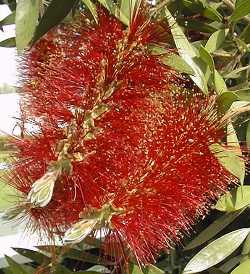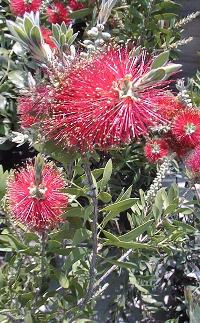Lemon Bottlebrush, Crimson Bottlebrush
Scientific Name: Callistemon citrinus (Curtis) Skeels
Synonym: Callistemon lanceolatus
Family: Myrtaceae
Sunset®: 8-9,11-24
AHS: 10-8
USDA: 8b-11
Frost Tolerance: Hardy in Phoenix
Heat Tolerance: Excellent
Sun Exposure: Full sun
Origin: Southeastern Australia
Growth Habits: Evergreen shrub or small tree, up to 10 to 25 feet tall (3-7.5 m) depending on the variety and the way it is trained; alternate, lethery, light green, elliptic leaves up to 6 inches long (15 cm), 0.5 to 0.8 inch wide (12-20 mm); new growth is pubescent, golden to copper-colored
Watering Needs: Little water when established, tolerates poor soils, needs good drainage and occasional deep watering
Propagation: Seeds (growing very slowly and giving seedling of great variability), semi-hardwood cuttings
Propagation: Cutting or occasionally seed
- by semi-hardwood secondary cuttings, in late spring. Use intermittent mist. Root in 10 weeks. Cut firm wood with stripes on bark...
- by seeds.

There are 20 odd species of Callistemon, all native to Australia. The leaves of Callistemon citrinus have a slight lemony flavor when crushed (that's were the name 'citrinus' comes from). It is often sheared to make hedges, in this case it doesn't bloom as much.
Blooming Habits:
The Lemon Bottlebrush bears conspicuous red flowers clusters, bottle-brush-like in shape, 1 to 1.6 inches long (2.5-4 cm), occuring principally in spring, but also occasionally during most of the year. The fruits are woody capsules.
Culture:
The Lemon Bottlebrush is very tolerant of heat, cold and bad soil. Use fertilizer for acid loving plants if it starts showing signs of chlorosis. To use as a screen, plant every 4 to 6 feet (1.2 m to 1.8m), trimming the upper part of the bush will be needed when the bottlebrush becomes older to keep the lower foliage.
Desert-Tropicals is dedicated to provide gardening advice, gardening ideas, and information about flower of all kind for landscape and collections.We try to check carefully the identification of the plants on the illustrations as well as the other information from the page, but occasionally errors do occur. if you notice anything that needs to be changed please contact us.Thanks.
© 1998-2020 Philippe Faucon, All Rights Reserved.
